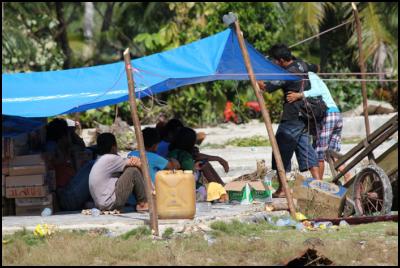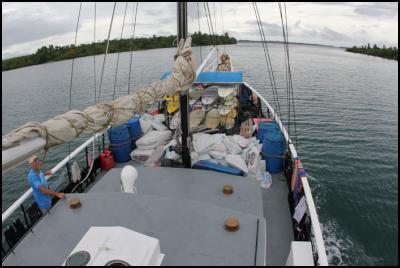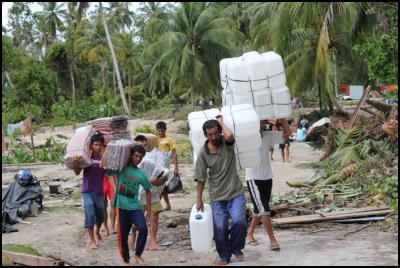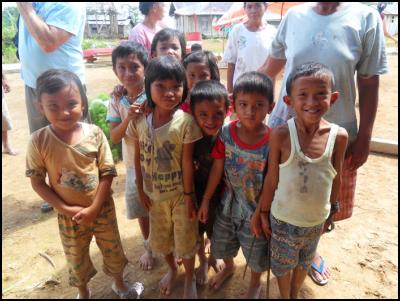SurfAid: First Phase of Emergency Response
SurfAid Completes First Phase of Emergency Response
SurfAid today completed the first phase of our Emergency Response for the Mentawai Islands which has concentrated on assessing the immediate needs of the affected communities and distributing food and non-food assistance. We now move into two new phases of Recovery programs which will last until the end of October 2011.
The 7.7M earthquake, which triggered a tsunami that has been recorded as being up to six metres (20 feet) high in some villages, struck 17 days ago at 9.41pm on Monday night 25 October.
The latest report from the Indonesian Government says that 447 people have been killed, 57 are missing, and 173 are seriously injured. More than 15,000 people have been displaced from their homes and are living in temporary shelters, many on the hills above their villages as they fear another tsunami.

Click for big version
More than 15,000
people have been displaced by the tsunami and are living in
temporary shelters. Photo: The Barrenjoey
Within 24 hours of the disaster, SurfAid had dispatched the Barrenjoey surf charter boat from Padang to make a rapid assessment of the damage in South Sipora Island and to deliver some initial assistance with tarpaulins and other shelter.
SurfAid Emergency Response (ER) Director Dr Alan Rogerson said that Captain John McGroder and his crew immediately wanted to get involved in the emergency and the surfers on board gave up their holidays to help.
“The Barrenjoey crew has now donated their time and skills to help SurfAid in four major disasters - the Boxing Day tsunami in December 2004, the March 2005 Nias earthquake; the 2007 Mentawai earthquakes; and now this disaster. It’s an extraordinary and humbling contribution,” Dr Rogerson said.
BJ skipper John McGroder has posted incredible accounts of their work for SurfAid here sumatransurfcharters.com.au

Click for big version
Heading out on the
Barrenjoey with emergency supplies. The surfers on board
gave up their holiday to help SurfAid. Photo: The
Barrenjoey
Our own speedboat, Sibex, also went into action on the first morning after the tsunami, making assessments of North and South Pagai Islands, and then providing distribution support for the charter boat fleet.
From 27 October to 7 November, SurfAid dispatched another seven boats to the stricken islands - Huey, Mangalui, Pono Indah, Indies Trader III and IV, Saranya and Kaimana.
As of today, SurfAid has made 96 visits to the communities. Our initial delivery of assistance focused on shelter, building and hygiene kits, and some kitchen and cooking kits. After a few days of distribution of non-food items, it became clear that communities were in danger of running short of food, so subsequent deliveries focused more on delivering food items - mainly rice, noodles and cooking oil.
We have dispatched the following to the Mentawai Islands: 3,100 shelter kits; 3,150 hygiene kits; 1,884 building kits; 661 cooking kits; 2,076 tarpaulins; 610 blankets; 380 mats; 405 lanterns; 170 bales of rope; 6,025kg of rice; 56,400 packets of noodles; 2,500kg of cooking oil; and 15,002 cans of fish.

Click for big version
Villagers gratefully receive emergency supplies. Photo: The Barrenjoey
SurfAid ER Director Rogerson said that the tsunami profoundly affected the Mentawai Islands.
“In some communities - such as Sabeugunggung, Muntei, Eruparaboat and Maonai - there was major loss of life and widespread destruction. In other communities - such as Bosua, Tumalei and Gogoa - there was little loss of life, but the communities did not escape destruction.
“Many communities on the west coast of North and South Pagai suffered some damage, and in other communities, where there was essentially no damage, people are still living in temporary shelters as they are too afraid to return home.”
Dr Rogerson said that SurfAid was able to act quickly in response to this tragedy largely because of the cooperative relationship we enjoy with the key players in the local surf industry.
“Within a few days of the tsunami we had seven boats in the water around the affected areas of Sipora and Pagai. We already knew what other organisations had to learn - that carrying assistance from Padang to the Mentawai is relatively easy by comparison to the task of distributing it to the communities that need it most,” Dr Rogerson said. “We have been active in the Mentawai for the past 10 years, and we plan to continue to work in the Mentawai over the long-term with our programs related to community health and wellbeing and disaster risk reduction." - SurfAid ER Director Alan Rogerson
CLICK HERE to watch SurfAid featured on Getaway, Channel 9 Australia “Accessing these communities, through the swell and the shore breaks, is difficult at the best of times. In the weather that hit the Mentawai in the week after the tsunami - a radical four-day storm described as the worst in years - this task became more difficult and much more dangerous. Yet the crew of the charter boats were up for the challenge as much as our own staff.
“The work they did, the effort they made and the commitment they demonstrated went way beyond what was written in the small print of our contracts,” Dr Rogerson said.
“Their courage was matched only by their local knowledge and experience and without these skippers and crews our food and non-food aid would have been sitting in Sikakap, instead of being in the hands of the survivors. This was a fantastic collaborative effort, and we are grateful to everybody who played a part.”
Dr Rogerson said that SurfAid is in for the long haul and is firmly focused on disaster recovery.
“We have been active in the Mentawai for the past 10 years, and we plan to continue to work in the Mentawai over the long-term with our programs related to community health and wellbeing and disaster risk reduction.
“We have support from AusAID, the New Zealand Aid Programme, the surfing industry, particularly Billabong, Quiksilver and Hurley, the global surfing community and the general public to facilitate the implementation of a range of projects, which will commence on 15 November 2010.”

Click for big version
Children from Balusat
were happy to see SurfAid teams arrive with supplies. Photo:
Howe/SurfAid
There is still a lot of work to be
done. In the months ahead this will be performed in two
phases:
Phase 1: Early Recovery 15 November 2010 – 20 February 2011
For these three months, SurfAid will provide three streams of activities:
1: Provision of a Posyandu Plus – a systemised Disease Prevention Treatment Project (DPTP)
2: A Psychosocial Support Program
3: A temporary shelter program, assisting the communities build temporary shelters until more sustainable solutions are provided via non-SurfAid assistance.
Phase 2: Recovery 21 February – end October 2011
Following the early recovery program there will be a nine-month recovery program. This will involve:
1. A continuation of Psychosocial Support Program for a further three months
2. A nine-month Sanitation and Hygiene program from 21 Feb
3. A nine-month Emergency Preparedness program from 21 Feb
4. A three-month Nutrition program from August
Thank you to everyone who has supported SurfAid during this disaster - we still need to raise $500,000 and appreciate all your help.
ENDS


 United Nations: UN Welcomes Ceasefire Between Israel And Lebanon
United Nations: UN Welcomes Ceasefire Between Israel And Lebanon UN News: One Woman Killed Every 10 Minutes - The Harrowing Global Reality Of Femicide
UN News: One Woman Killed Every 10 Minutes - The Harrowing Global Reality Of Femicide Fulbright New Zealand: Announcing The 2025 Ian Axford Fellows In Public Policy
Fulbright New Zealand: Announcing The 2025 Ian Axford Fellows In Public Policy Steven Ratuva, The Conversation: COP29 - ‘Climate Finance’ For The Pacific Is Mostly Loans, Saddling Small Island Nations With More Debt
Steven Ratuva, The Conversation: COP29 - ‘Climate Finance’ For The Pacific Is Mostly Loans, Saddling Small Island Nations With More Debt ITUC: Trade Unions In Action Against Gender-based Violence - 16 Days Of Activism
ITUC: Trade Unions In Action Against Gender-based Violence - 16 Days Of Activism 350.org: Climate Movement Holds Steadfast As Wealthy Nations Fail To Deliver On Climate Finance At COP29
350.org: Climate Movement Holds Steadfast As Wealthy Nations Fail To Deliver On Climate Finance At COP29